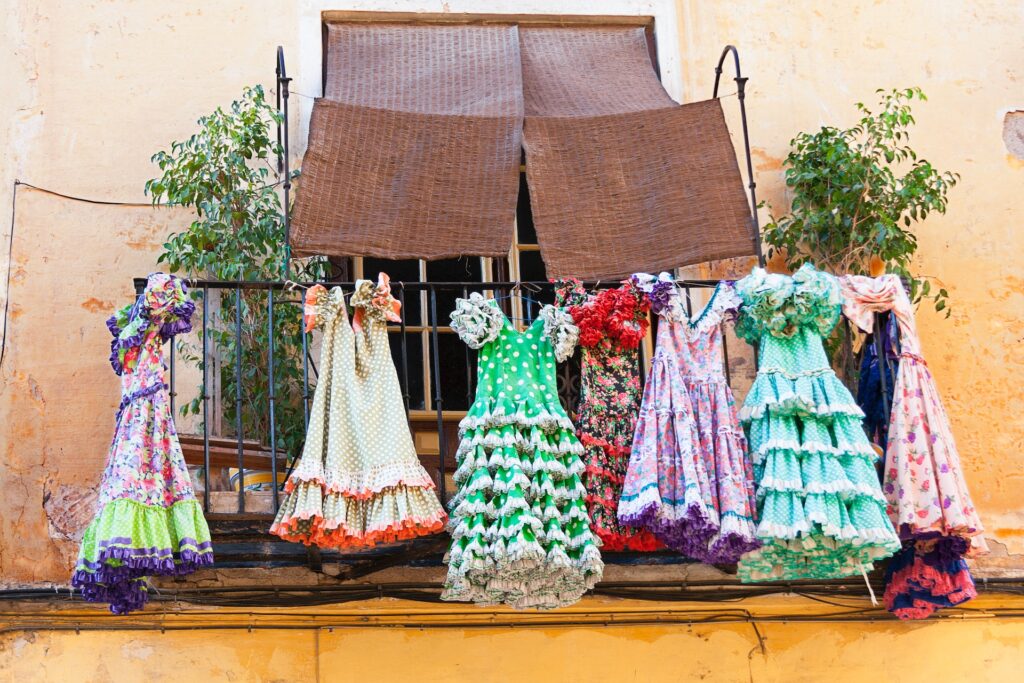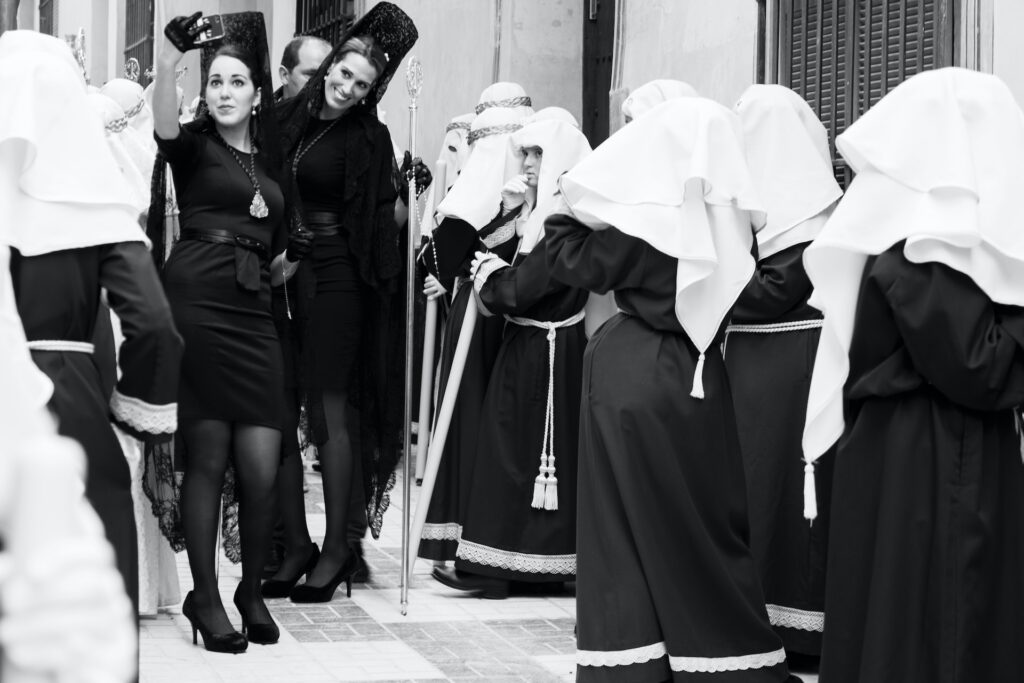Spain Traditional Clothing captures Spain’s history as well as its cultural background. Different clothing and styles serve as unique identities for the different cultural groups. Also, they function as an embodiment of cultural diversities and present us with the multiple phases that exist in society. The tradition of each region is woven into its fabric.
Every region is proud of its unique designs, as they all create eye-catching designs of clothes that are meant to meet different needs and perform different functions. For example, the Andalusian regional clothes made from light fabric are meant to provide comfort during the summer, while the northern region clothing helps to protect against the cold weather. Apparently, Spain traditional clothing is versatile and is still relevant up until this present time.
Several factors have influenced Spanish fashion and style. For example, the Moorish culture had a significant influence on Spain traditional clothing as it introduced needles, jewelry, and heavy girdles. This has transformed Spanish traditional clothing, as it is now made from heavy fabrics and materials. The different spain traditional attires and the intentionality that has been put into making them have brought about the recognition of the creativity and craftsmanship of Spain.
In today’s post, we’ll be discussing the history of Spain traditional clothing, including the different types of traditional Spanish clothing.
So, let’s go!
The Historical Evolution of Spain Traditional Clothing
The history of Spain traditional clothing will provide us with different changes, influences, and factors regarding Spain traditional clothing and we shall look into them in stages.
-
The Pre-Roman Era (5th A.D.)
The earliest traditional clothing of the Spanish can be traced to the Iberians and the Celts, who occupied this region before the region was conquered by the Romans and became a Roman conquest. During this period, clothes were made from wool and linen, then dyed and decorated with earthy stones.
-
The 8th–15th Century
In the early 8th century, the Moors invaded the Iberian Peninsula. From the start of the 5th century to the 8th century, the Moors brought luxurious fabrics with intricate designs. Also, the introduction of the pin led to a new way of making clothes in Spain. The impact of Moorish attire can be seen in the southern part of Spain, where garments made from luxurious textiles were prominent.
The Middle Ages (10th–15th century)
During this period, the clothing style and clothing of Spain were influenced by the Arabs because many of the regions were greatly occupied by the Muslims. The Islamic religion played a significant role in the clothing and lifestyle of the people. Leather, silk, and other Muslim attire that were introduced in this period recorded great success. Fabrics like leather and silk from Muslim regions were introduced into Spain.
Muslim attire and wear like turbans, Moorish tights, calzas moras, shirts, and other clothes are present in the Al-Andalu region of Spain and are still very present. In the 14th century, the elites and nobles adapted to new fashion and style, such as the simple gowns, which mostly existed in black and white. They were adorned and beautified with different fashion accessories, like gold chains and precious buttons.
-
The Golden Age (16th–17th century)
This period was during the reign of Philip II. Spanish cultural attire was promoted as there was a trend where dressing in Spanish traditional costume became a norm. It was during this period that Spanish fashion gained much recognition in Europe and Latin America. This time, Spain had political control over the peninsula.
One of the unique qualities of Spain is its cultural diversity and uniqueness. Spain is made up of different cultural groups with different climates and languages. The climate was a major determinant of the type of food cultivated and the type of clothing worn. For example, the major occupation of the Castile region of Spain was livestock rearing, and as a result, they produced wool in large quantities used in making cloth. Valencia is known for silk weaving.
Different types of clothing dyes that were used for clothes were produced in colors like red and black. In the 16th century and toward the start of the 17th century, people of higher status in Spain began to embrace colorful silk. The men wore quilted breeches, while the women wore galas, which were made with embroidery and silver trimmings.
-
The 17th–19th Century
This era also had an effect on Spanish traditional clothing because of the type of religion that existed during this period. Catholicism was the major religion practiced in the whole peninsula, and black was the major color common in their clothing. The clergy’s attire was black. The black color connotes a morning phase.
Veils were worn by women to cover their heads and shoulders before entering the church.The different centuries have provided different traditional clothes in Spain, which have been determined by different influences. These clothes have helped modern designers create other beautiful clothing designs that are in existence at present.
Types of Spain Traditional Clothing
Here, we’ll be discussing the different types of Spain traditional clothing which include;
1. Traje de Flamenca

The flamenca is a colorful dress with ruffles that is worn by flamenca dancers. It is one of Spain’s regional traditional clothing, originating in the Andalusia region. There are two types of flamenca. There is a flamenca outfit that is worn by the flamenca dancers, and there is one that is worn as a regular outfit.
The regular flamenca used as everyday attire is made to fit the body to the mid-thigh, then ruffles are sewn to the cloth in different layers. The flamenca made for dancers has its lower part decorated with frills and ruffles as well, but it is designed to free the flares from the hip to allow for free movement during performance.
Traditionally, the costume is usually accompanied by a manila shawl. The shawl is worn to cover the shoulders. The woman’s hair is also tied up in a bun and decorated with flowers. It can also be accompanied by other accessories.
2. Traje de Corto
This also belongs to the regional traditional costume in Spain. It belongs to Andalucía. It is a short suit that is usually worn with a wide hat, a white shirt, and a jacket. Traje de Corto is worn by the men when performing flamenco.
3. Fallera
Fallera is a Spanish traditional garment that originated in the Valencia region of Spain. It is worn by women in Spain. It is made up of a skirt that is made of colorful floral designs. The shoulder of the cloth has an apron on the shoulders, which is usually tied to the waist. Different accessories were usually worn by women to complement the look with matching footwear.
4. Bolero Jacket
The origin of the Bolero jacket dates back to Spanish bullfighting, where a cropped jacket known as a Zouave was worn. This Zouave was reinvented as a Bolero jacket in the 20th century. This is a short or cropped jacket that is made from cotton, satin, silk, or velvet. It provides coverage for the arm, the upper torso, and the back. It can be worn on a blouse or a bodice. The Bolero jacket is not suitable during the cold period because of its short arm.
5. Tricorn Hat
In the 18th century, the tricorn hat was referred to as the ‘cocked hat’. The name Tricorn came into being in the mid-19th century. It was a hat made from animal fiber. The hat has three sides, which are turned up at the brim.
6. Mantilla

A mantilla is a traditional shawl or silk veil that is worn on the head. It was one of the traditional clothing styles influenced by the Catholic Church, as it was usually worn over the head by women. Women usually wear white mantillas to church, especially during the holy week.
7. Faja
Faja is a form of Spanish traditional clothing that is usually worn by women. It is usually worn around the waist to keep the swelling from the stomach down. Faja is used by women after an operation or after delivery to keep the body in shape. It has inspired different shapewear companies that have developed what we call waist trainers today. The faja serves as a model for the waist trainer.
8. Espadrilles
This is footwear that belongs to Spain traditional clothing. They are made from fabrics or jute rope and worn during the summer. The word Espadrilles was derived from a Spanish word known as ‘espardenya’, which is a plant used in making espadrilles. It was worn by both men and women. It originated in the Catalonia and Basque regions of Spain.
9. Gilet

Gilet is a sleeveless jacket that is usually worn by Spanish men. They are usually worn over a shirt, and they provide extra warmth. Gilet is the perfect clothing when you’re between-the-season. Moreover, it is usually lightweight, making it easy for you to roll it up and pack into a briefcase or backpack. Gilet is a much loved traveling companion.
10. Basque Beret
The basque beret is a type of traditional Spanish headwear. It is usually a flat, rounded cap that is made from hand-knitted wool or felt wool. Berets were already common headwear in Northern Spain. However, its production in large quantities began in Northern Spain in the 19th century, and the beret is still associated with Spain. Basque berets are worn as part of military or police uniforms worldwide, as well as by other organizations.
Last Words on Spain Traditional Clothing
In this article, I have successfully shared with you the Spain traditional clothing. These garments often represent Spanish identity and regional pride. They’re also deeply rooted in the country’s culture, festivals, and celebrations. Spain’s traditional clothing has remained one of the most fashionable traditional wears that has continued to develop and has been influenced by several factors, from religion to political influence to regional preference.
Different cultural groups, namely Basque, Galician, Castilian, Catalan, etc., that make up Spain have contributed to enriching Spain with different clothing and styles. The effort that has been put into making the different Spanish traditional clothing has earned Spain recognition for its innovative spirit and craftsmanship.



